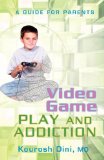Dini’s Video Game Play and Addiction Deserves Five Stars

Video Game Play and Addiction – A Guide For Parents
Author: Kourosh Dini, MD
April 2008
151 pages
Update: Video Game Play & Addiction has received a 2009 Silver Award from Mom’s Choice Awards in the Resources category.
This book impressed me from the moment I cracked the cover and began reading. Kourosh Dini has written the most comprehensive, wide-view truth about game play and addiction book that I have read to-date.
In no way is this book stuffy or full of statistics and scientific mumbo-jumbo; instead, Dini uses a common-sense approach to the topic, but he does not limit his discussion solely to children who are addicted to video games. He begins by talking about the positive aspects of gaming, and why humans like to game – to learn and to enjoy the aspects of play in our lives. Play and Addiction gets extra points from me because the author discusses the fact that our school systems are very outdated and no longer meet the needs of our tech-savvy children.
Parents are also encouraged to be an active part of their child’s game play – observe, participate – learn and play together. I think that this is a very important section of the book, because as parents in a high-achievement oriented business world, time to play and connect with our children can often become a lower priority. One of the biggest benefits of following Dini’s suggestions is that we remain able to converse with our children, to know who they are, what they are doing, and why they like to play the games they do.
Dini freely admits that the possibility of addiction is always on the horizon, but he also encourages parents to look beyond the end-resulting addiction or obsession and investigate the underlying causes. In other words, seek professional assistance if necessary, but don’t just blame video games if your child is having emotional difficulties which inevitably led to the addictive levels of play. His approach to investigating these problems reminds us that as parents, we are have a responsibility to our children to assist them however we can to make their way through each level of life.
The author has successfully intertwined his past and present as a gamer, a parent and a psychiatrist to compose a book which in my opinion, should be read by parents of gamers, teachers, game developers and even those who oppose video games. At only 151 pages including footnotes and bibliography, Video Game Play and Addiction can be easily read over the space of a few hours (I’ve read it twice), and Dini’s writing style flows easily from one topic to the next, making for a very good read. He also offers a wealth of sources and resources for further investigation by parents on the topics he has covered in his book – again, suggesting that a parent be pro-active when it comes to their children and games.
As I’ve said above, I highly recommend this book to parents, teachers, game designers and even game opponents. I may even lend this book to my own Mother to have a read-through – after all, it’s my parents’ fault that I’m a gamer; they’re the ones who brought home the Atari 2600 all those years ago. Oddly enough, I play games for many of the same reasons which Dini addressed in the first few chapters of his book, so I believe I can truthfully say that the author knows of that which he writes.



